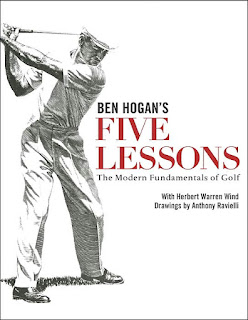I daresay that the words 'automatic' or 'automatically' are key words for the whole book. These notions were used 12 times in the most famous book in the history of golf instruction titled "Ben Hogan's Five Lessons. The Modern Fundamentals of Golf". Let us have a closer look into this topic and validate the point that Ben Hogan wanted as large automatism as possible in the motion and he believed that crucial positions or movements are to be achieved automatically.
If one asks for the most concise summary, the book's content may be shortened to the following main points:
- stance governs automatically correct pelvic motion;
- pelvic motion governs automatically shoulders motion;
- shoulder motion governs automatically arms and hands that do nothing (active, conscious) in the swing provided one has a correct grip;
- provided the backswing is done correctly the downswing is a chain of unintentional biophysical events following each other automatically because there are no other options left.
Not by coincidence, the last sentence is the essence of the theory of natural limitations in the hard structure of human organism and, consequently, a firm motto of the Biokinetic Golf Swing Theory.
THE CORRECT STANCE ACTS AS A PERFECT AUTOMATIC GOVERNOR ON THE AMOUNT OF HIP TURN THE GOLFER CAN TAKE (AND SHOULD TAKE) ON THE BACKSWING. (p. 43 of the book)
We do not need to mention that, according to the SPC concept and the Diagonal Stance idea (especially rear leg ankle and knee joints presets), a golfer can position his joints during setup the way they cause an automatic transition from the ground up. Hogan underlines here especially how to achieve automatically a correct hip turn followed by unintentional using of the tension between hips and shoulders area.
The downswing, you see, is initiated by turning the hips back to the left. When you have this stored-up tension in the muscles between the hips and the shoulders (and in the muscles of the thighs that work with the hips), you have something with which you can begin the downswing. (This tension will, in fact, automatically help to pull you down into the ball.) As the hips turn back to the left, this turning motion increases their tension. IT IS THIS INCREASED TENSION THAT UNWINDS THE UPPER PART OF THE BODY. IT UNWINDS THE SHOULDERS, THE ARMS AND THE HANDS IN THAT ORDER, THE CORRECT ORDER. IT HELPS THE SWING SO MUCH IT MAKES IT ALMOST AUTOMATIC. (p. 71 of the book)
The turning of the hips inaugurates the downswing. This movement of the hips automatically lowers the arms and hands to a position just above hip level. (p. 94 of the book)
It would be tough to find a better concise prayer for sequentiality of the motion both from the ground up as well as from the core out.
The last paragraph, however, strikes even more important aspect, namely, lack of conscious actions and using a subconscious-friendly unintentional motion where there is no place for independent arm or hands activities. Properly built grip and a great body action is enough.
THE ACTION OF THE ARMS IS MOTIVATED BY THE MOVEMENTS OF THE BODY, AND THE HANDS CONSCIOUSLY DO NOTHING BUT MAINTAIN A FIRM GRIP ON THE CLUB. (p. 82 of the book)
Finally, Mr.Hogan underlines that the timing factor is being considerably reduced provided the automatism is being brought into the swing and forms the chain of subconscious-friendly physical events -- what is, not coincidentally, our main goal in our biokinetic golf swing theory.
The golf swing we have presented in this series is the essential golf swing, stripped down to its authentic fundamentals. They are all the golfer needs in order to develop a correct, powerful swing that will repeat. If he learns to execute these fundamental movements—and there is no movement in this swing which a man or woman of average coordination cannot perform—he will continue to become a more and more skillful player. He will not have to worry constantly about his timing, for example, as does the player who thinks he can construct a swing on hand action and who, since this is impossible, is doomed to be erratic. The golfer whose swing is founded on chain action cannot help but have timing. The swing is already timed for him. The chain action itself is the timing. (p. 122/123 of the book)
It is a marvellously great thing to find out that the best ballstriker that ever lived and the biggest authority in golf until now sought for and found somehow the same goals as the author of this site. Thank you, Mr.Hogan, for a continuous inspiration.

















